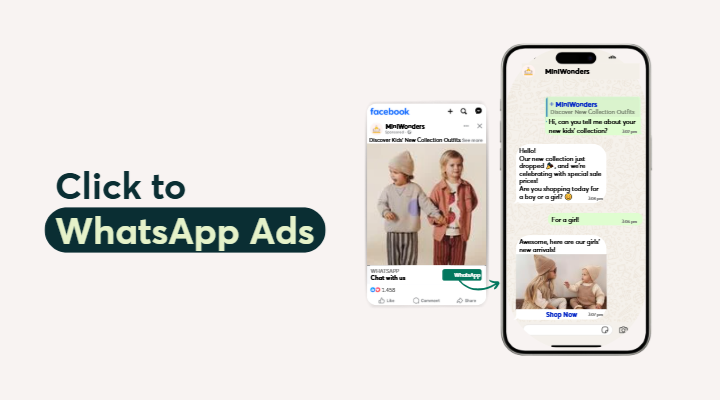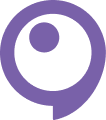With just one click, the user moves from a social platform (Facebook, Instagram, etc.) to a conversation with your business on WhatsApp. This creates an instant, personal connection that can lead directly to a sale.
In this article, we’ll go step by step on how to set them up properly, manage leads, and improve your results.
At a glance
- What Click-to-WhatsApp ads are
- What you need before you start
- How to run a campaign effectively
- Turning conversations into sales
- Common mistakes to avoid
- A step-by-step action plan
What are Click-to-WhatsApp ads
Click-to-WhatsApp ads are campaigns that appear primarily on Facebook and Instagram with a call-to-action button like “Send Message on WhatsApp.” When the user clicks, a chat with your business opens automatically.
Unlike classic ads that drive to landing pages or forms, here the interaction is immediate. That means:
Personal, real-time communication – customers ask what they want, and you reply instantly.
Higher-quality leads – anyone who takes the time to send a message is already “warmer” and closer to buying.
Lower costs – with no forms or unnecessary steps, drop-offs are reduced and conversions increase.
What you need before you start
Before investing in a Click-to-WhatsApp campaign, it’s important to have a clear strategy. The right decisions at this stage will determine whether your campaign drives real results or gets lost in the advertising noise.
Clear objectives: What do you want to achieve? More leads, more traffic, direct sales? A defined goal will shape both your message and your campaign flow.
Proper audience targeting: Success depends on whether your messages reach the right people. Focus on those who are genuinely interested in your products or services—based on demographics, interests, or past interactions with your business.
Compelling creatives: The ad copy and visuals should make it crystal clear why it’s worth sending you a WhatsApp message. Use short phrases, clear benefits, and eye-catching visuals.
Prepared conversation starters: The easier you make the first step, the higher the response. A pre-filled message like “Hi, I’d like more information about…” lowers hesitation and increases the chance that users will actually start chatting.
How to run your campaign effectively
Execution makes all the difference. Some best practices include:
Automation & chatbots: Use auto-replies for greetings, FAQs, or to filter out casual inquiries. A bot can ask quick qualifying questions (e.g., budget, product interest) before passing the lead to a human.
Fast responses: Users expect an instant reply. The faster you respond, the more likely they are to purchase.
Targeted replies: Don’t send generic answers. If you know what the customer is asking for, tailor your response.
Offers or incentives: A special discount, free sample, or early-bird deal can be the extra nudge a customer needs.
Turning conversations into sales
The first message is just the beginning—the follow-up is what really counts. To make the most of leads:
-
Design a communication flow:
-
Instant auto-reply with a thank-you message and basic info.
-
Within the same day, follow up with answers to FAQs or a useful link.
-
If there’s no response, send a reminder or special offer later.
-
-
Personalization: Refer back to the needs the customer already mentioned. This shows attentiveness and professionalism.
-
Blend automation with human touch: Bots help with flow, but a real person is the one who builds trust and closes the sale.
-
Track results: Measure response times, conversion rates, cost per lead. Use this data to refine your strategy.
Common mistakes to avoid
Even a well-set-up Click-to-WhatsApp campaign can fail if you fall into these traps:
Slow responses: If a user messages you, they expect an immediate reply. If you delay, their interest drops—or they turn to a competitor. A quick auto-reply can buy time until a human takes over, while still showing your business is available.
Over-automation: Auto-replies and chatbots are useful for basics, but if the customer feels they’re talking only to a robot, the personal touch is lost. Balance is key—use bots for simple inquiries, but let humans handle more complex cases and close sales.
Unclear ad messaging: A Click-to-WhatsApp ad must clearly state why it’s worth sending a message. If your ad is vague, most users will ignore it. Instead of “Learn more,” try something specific like “Message us to get 20% off your first purchase.”
Poor lead management: Every message in WhatsApp is a valuable lead. But if you don’t log, categorize, and track them, they’ll slip through the cracks. Use tagging or lists to distinguish hot leads from those that need nurturing, so you can do more targeted follow-ups.
A simple step-by-step plan
For a clear strategy, follow these steps:
-
Set objectives: Define what you want to achieve. More sales? Leads for your sales team? More website traffic? Your goal determines how you’ll structure the campaign.
-
Create compelling creatives & a starter message: The copy and visuals should spark interest and provide a clear incentive. A pre-filled message (e.g., “Hi, I want to learn about your offer”) makes it easy for users to start chatting.
-
Target the right audience: Campaigns only perform if they reach genuinely interested people. Use demographics, lookalike audiences, or retargeting to find the most relevant users. This increases conversions and lowers costs.
-
Use automation for speed & filtering: Automation ensures every user gets an immediate reply. A bot can collect basic info (like product interest) and give quick answers. This filters leads so “hot” prospects go directly to sales.
-
Manage conversations consistently with follow-up: Never leave a conversation hanging. Even if someone doesn’t buy right away, nurture them: a thank-you message, reminder, or offer a few days later can make the difference.
-
Measure & improve: Track key metrics like response time, sales conversion rate, and cost per lead. Analyze what’s working and what isn’t, then optimize continuously.
Click-to-WhatsApp campaigns aren’t just a variation of classic social ads. They fundamentally change how you connect with your audience—offering immediacy, a personal touch, and higher chances of conversion.
But success doesn’t come just from clicking a button. It requires speed, personalization, and a smart follow-up strategy. With a campaign that has a clear goal, fast responses, and effective lead management, WhatsApp can become one of the most powerful growth drivers for your business.

